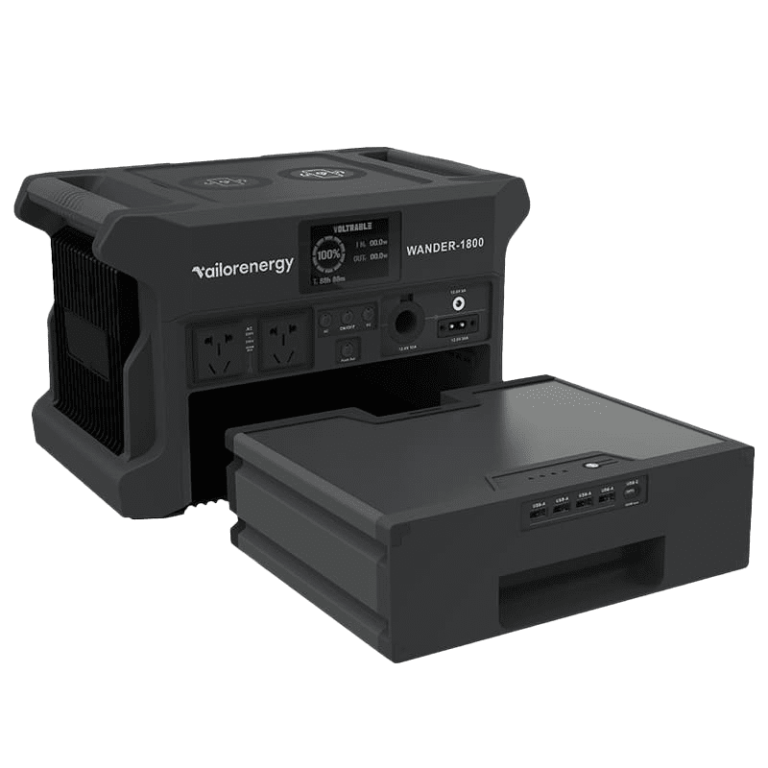Portable energy storage, in simple terms, is essentially a large power bank, possessing a greater capacity and output power, capable of storing electrical energy to power or charge various devices.
Unlike traditional generators, most portable power stations do not use gasoline or diesel fuel, making them more environmentally friendly. They typically employ high-capacity lithium-ion batteries that can be charged through wall outlets, solar panels, and sometimes even car outlets.
Features and Uses:
- Multifunctional: Portable power stations come with multiple output ports, allowing users to power a variety of devices such as smartphones, laptops, cameras, and even small appliances.
- Portability: They are lightweight, compactly structured, and designed for convenient transport, making them perfect for camping trips, outdoor activities, or as an emergency backup power supply.
- Silent Operation: Unlike fuel generators, battery-powered stations operate quietly and do not emit exhaust, making them suitable for indoor use.
- Ease of Use: Most portable power stations feature user-friendly interfaces with clear power level and output option indicators.
Benefits:
- Eco-friendly: They are emission-free and have a lower carbon footprint compared to fuel generators.
- Reliable: They provide dependable power supply during power outages or in remote areas.
- Convenient: They offer on-demand power supply anytime and anywhere.
Portable power stations are popular among outdoor enthusiasts, photographers, and anyone in need of power in remote areas or emergency situations. They are an essential tool in disaster preparedness kits. For those who require reliable, portable power supply on-the-go, they are a practical solution.
How to charge a portable power station?
Under normal circumstances, there are three ways to charge portable power stations:
- Charging via AC wall outlet.
- Charging with solar panels.
- Charging through a car cigarette lighter to Xt60 port.


Charging via AC Wall Outlet:
- Find the power adapter that comes with the portable power station and plug in the adapter.
- Connect the power adapter to the charging input of the power station and then to the wall outlet.
- Once fully charged, unplug the power adapter from both the wall outlet and the power station.
Charging with Solar Panels:
- Connect the solar panel to the solar input port on the portable power station and place the solar panel under the sun.
- Place the solar panel where it can receive maximum sunlight, usually in a clean, open area directly under the sun.
- Once the power station is fully charged, disconnect the solar panel.
Charging via Car:
- Find the car charging cable compatible with your portable charging station and connect the cable.
- Plug one end of the cable into the 12V input port of the power station and the other end into the car’s 12V socket.
- Start the car engine to begin charging the power station. Monitor the charging process by observing the battery level or indicator lights.
- Once fully charged, unplug the cable and disconnect the car charging wire.
Remember to monitor the charging process to avoid overcharging, and always follow the manufacturer’s instructions for safe and optimal charging of the portable power station.
How long does a portable power station last?
Under normal circumstances,
- Lithium-ion batteries: Typically last for about 300 to 500 charging cycles.
- Lead-acid batteries: Typically last for about 200 to 300 charging cycles.
However, our model, which utilizes a semi-solid state cell, can maintain more than 70% of battery capacity after 2000 cycles.
To extend the service life, here are a few tips:
- Regular Maintenance: Regularly check for any issues or defects.
- Proper Storage: Store in a cool, dry place and avoid exposure to extreme temperatures.
- Optimal Charging: Avoid letting the battery completely run out; recharge it when the power is around 20%.
- Avoid Overloading: Do not connect devices that draw high power.



